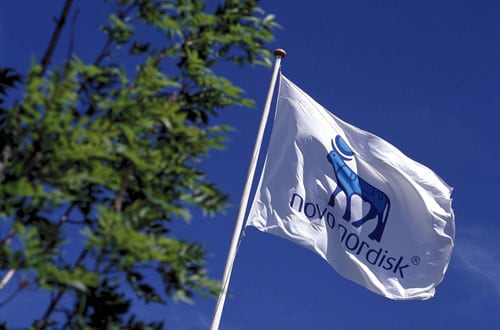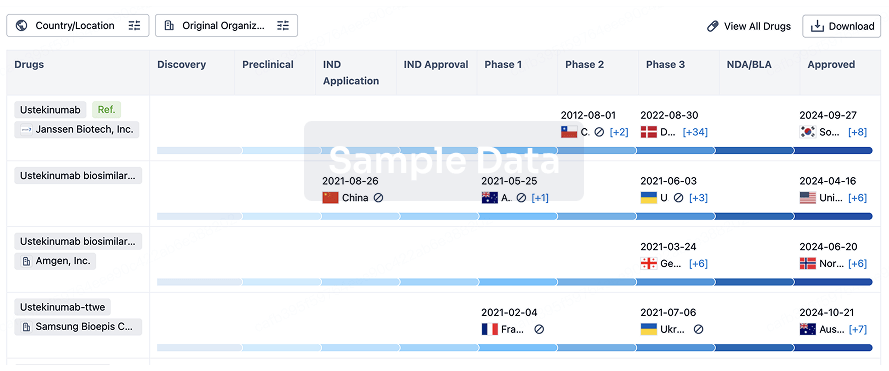Request Demo
Last update 29 Nov 2025
Semaglutide (CSPC Zhongqi)
Last update 29 Nov 2025
Overview
Basic Info
Drug Type Recombinant polypeptide |
Synonyms HD 1916, HD-1916, HD1916 + [1] |
Target |
Action agonists |
Mechanism GLP-1R agonists(Glucagon-like peptide 1 receptor agonists) |
Therapeutic Areas |
Active Indication |
Inactive Indication- |
Originator Organization |
Inactive Organization- |
License Organization- |
Drug Highest PhaseNDA/BLA |
First Approval Date- |
Regulation- |
Login to view timeline
Related
5
Clinical Trials associated with Semaglutide (CSPC Zhongqi)NCT06830343
A Phase I Clinical Trial to Evaluate the Safety, Tolerability, and Pharmacokinetic of SYH9017 in Chinese Participants With Overweight and Obesity Following Single and Multiple Doses
This is a randomized, double-blind, single-center, dose-escalation, single ascending dose and multiple ascending dose study of SYH9017 in Chinese participants with overweight and obesity.
Start Date27 Feb 2025 |
Sponsor / Collaborator |
NCT06604624
To Evaluate a Multicenter, Randomized, Open, Positive Parallel Controlled Phase III Clinical Trial of Semaglutide Injection (HD1916) in the Treatment of Obesity
This is a multicenter, randomized, open, positive parallel controlled phase III clinical trial to compare the efficacy and safety of once-weekly HD1916 and semaglutide injection and to evaluate immunogenicity in obese non-diabetic adults.
Start Date20 Sep 2024 |
Sponsor / Collaborator |
CTR20233923
在2型糖尿病患者中评价司美格鲁肽注射液(HD1916)与诺和泰®的有效性和安全性的多中心、随机、开放、平行对照Ⅲ期临床试验
[Translation] A multicenter, randomized, open-label, parallel-controlled phase III clinical trial to evaluate the efficacy and safety of semaglutide injection (HD1916) and Novotel® in patients with type 2 diabetes
主要目的:
在接受盐酸二甲双胍治疗的2型糖尿病患者中,证明司美格鲁肽注射液(HD1916)与诺和泰®治疗后第32周时降低HbA1c的疗效相似性。
次要目的:
在接受盐酸二甲双胍治疗的2型糖尿病患者中,比较司美格鲁肽注射液(HD1916)与诺和泰®治疗后其他疗效终点的相似性、安全性和免疫原性、PK特征。
[Translation]
Primary objective:
In patients with type 2 diabetes treated with metformin hydrochloride, to demonstrate the similarity of the efficacy of semaglutide injection (HD1916) and Novota® in reducing HbA1c at week 32 after treatment.
Secondary objective:
In patients with type 2 diabetes treated with metformin hydrochloride, to compare the similarity, safety, immunogenicity, and PK characteristics of semaglutide injection (HD1916) and Novota® in other efficacy endpoints after treatment.
Start Date23 Feb 2024 |
Sponsor / Collaborator |
100 Clinical Results associated with Semaglutide (CSPC Zhongqi)
Login to view more data
100 Translational Medicine associated with Semaglutide (CSPC Zhongqi)
Login to view more data
100 Patents (Medical) associated with Semaglutide (CSPC Zhongqi)
Login to view more data
146
Literatures (Medical) associated with Semaglutide (CSPC Zhongqi)01 Jan 2026·METABOLISM-CLINICAL AND EXPERIMENTAL
Semaglutide, the first approved GLP-1 receptor agonist for the management of metabolic dysfunction-associated steatohepatitis
Author: Boutari, Chrysoula ; Mantzoros, Christos S ; Hill, Michael A
01 Nov 2025·DIABETES OBESITY & METABOLISM
Lower risk of cardiovascular events in patients initiated on semaglutide 2.4 mg in the real‐world: Results from the
SCORE
study (Semaglutide Effects on Cardiovascular Outcomes in People with Overweight or Obesity in the Real World)
Article
Author: Zhao, Zhenxiang ; Smolarz, B. Gabriel ; Smolderen, Kim G. ; Nanna, Michael G. ; Michalak, Wojciech ; Mena‐Hurtado, Carlos ; Faurby, Mads ; Song, Jinlin ; Kosiborod, Mikhail N. ; Chen, Yan ; Boland, Joanna
Abstract:
Aims:
In this first interim analysis of the SCORE study, we investigated the risk of major adverse cardiovascular events (MACE) among individuals with atherosclerotic cardiovascular disease (ASCVD) and overweight/obesity but without diabetes who initiated semaglutide 2.4 mg in real‐world settings.
Materials and Methods:
Individuals initiating semaglutide 2.4 mg aged ≥45 years with ASCVD and overweight/obesity but without diabetes were identified in a US database (01/01/2016–12/31/2023) and matched 1:2 to those not on semaglutide based on a non‐parsimonious propensity‐score model. The primary outcomes included revised 3‐point MACE (rMACE‐3: myocardial infarction, stroke, and all‐cause mortality) and revised 5‐point MACE (rMACE‐5: rMACE‐3, coronary revascularisation, and hospitalisation for heart failure). Secondary outcomes included MACE‐3 and MACE‐5, defined similarly to rMACE‐3 and rMACE‐5 but replacing all‐cause mortality with cardiovascular‐related mortality. Exploratory outcomes included incident type 2 diabetes, major adverse kidney events, and major obesity‐related adverse events.
Results:
A total of 9321 individuals on semaglutide 2.4 mg were matched to 18,642 individuals not on semaglutide; patient characteristics were well‐balanced between cohorts. Over a mean follow‐up of 200 days, semaglutide 2.4 mg was associated with significantly lower risks of rMACE‐5 (hazard ratio: 0.55;
p
< 0.001), rMACE‐3 (0.43;
p
< 0.001), MACE‐5 (0.65;
p
< 0.001), and MACE‐3 (0.58;
p
< 0.01). Semaglutide 2.4 mg was also associated with lower risks of all‐cause mortality, cardiovascular‐related mortality, hospitalisation for heart failure, and all exploratory outcomes.
Conclusions:
In this real‐world study of US individuals with ASCVD and overweight/obesity but without diabetes, semaglutide 2.4 mg was associated with significantly reduced risk of MACEs and other obesity‐related morbidities (NCT06874751).
01 Oct 2025·DIABETES OBESITY & METABOLISM
Novel oral agents in anti‐obesity pharmacotherapy: A narrative review
Review
Author: Buch, Assaf ; Eldor, Roy ; Brown, Roy ; Zonszein, Joel
Abstract:
Obesity remains a critical global health issue with profound medical and economic implications. While injectable medications such as
semaglutide
(Wegovy®) and
tirzepatide
(Zepbound®) have demonstrated significant efficacy, the development of novel oral anti‐obesity agents presents additional therapeutic potential. This narrative review examines recent advances in oral pharmacotherapy for obesity, focusing on mechanisms of action, clinical effectiveness, anticipated benefits and side effects. A systematic search of PubMed, Cochrane Library, Google Scholar and
ClinicalTrials.gov
identified relevant studies published between January 2023 and June 2025, including randomized controlled trials and clinical investigations of emerging oral agents. We have selected emerging oral compounds, currently undergoing clinical evaluation but not yet approved by the Food and Drug Administration (FDA). These include oral GLP‐1 RAs, peptides and small molecules, and non‐incretin‐based therapies targeting the melanocortin‐4 receptor and the endocannabinoid system, among others. Several agents have demonstrated promising efficacy, achieving weight loss of ≥10% in clinical trials while also exhibiting favourable safety profiles. Emerging oral therapies could complement or serve as alternatives to approved injectable treatments, particularly for long‐term weight management. They may enhance patient access, adherence and satisfaction, thereby broadening the scope of pharmacological interventions in obesity care. Ongoing research is crucial to confirm the long‐term safety, effectiveness and clinical role of these agents within comprehensive obesity management strategies. By contextualizing these developments, this review underscores the growing promise of oral pharmacotherapy in addressing the global obesity epidemic.
9
News (Medical) associated with Semaglutide (CSPC Zhongqi)07 Nov 2025
Results, presented at ObesityWeek® 2025, showed patients receiving NG101 saw 40% reduction in nausea incidence and 67% reduction in vomiting incidence Only 30% of patients who start GLP-1s for weight loss are still using them after one year, with GI side effects cited as the #1 cause of treatment discontinuationNG101 is a first-in-class therapy being evaluated for GLP-1-induced nausea and vomiting, the source of billions of dollars in annual lost revenues WOBURN, Mass., Nov. 07, 2025 (GLOBE NEWSWIRE) -- Neurogastrx, Inc., today presented proof-of-concept data from its placebo-controlled Phase 2 clinical study of NG101 (metopimazine mesylate), an oral, peripherally restricted dopamine D2 receptor antagonist for the treatment of GLP-1-induced nausea and vomiting. These data, shared in an oral presentation at ObesityWeek® 2025, demonstrated that NG101 significantly reduced the incidence, duration, and severity of nausea and vomiting associated with the use of a GLP-1 agonist. “GLP-1 agonists can be life-changing for individuals with obesity. Yet for so many, the common GI side effects of nausea and vomiting are often unbearable, leading to patients discontinuing treatment or being unable to reach optimal doses,” said Sean Wharton, MD, PharmD, Medical Director, Wharton Medical Clinic for Weight and Diabetes Management, Ontario, Canada, and an adjunct professor at both McMaster University in Hamilton and York University in Toronto. “An oral treatment such as NG101 may make GLP-1 receptor agonists tolerable for many patients.” Key Results from Clinical Study of NG101 for Semaglutide-Induced Nausea and Vomiting In the study, a total of 90 participants aged 18-55 received a single subcutaneous dose of semaglutide (0.5 mg), along with five days of NG101 20 mg twice per day (BID) or placebo. The study evaluated the efficacy of NG101 in reducing the incidence, duration, and severity of nausea and vomiting. Key clinical study results showed that, compared to placebo, NG101 significantly: Reduced the incidence of nausea by 40% (p=0.0203)Decreased the incidence of vomiting by 67% (p=0.0274) and the number of discrete vomiting episodes by 56% (p=0.0238)Reduced the duration of nausea and vomiting (p=0.0063); events lasting more than one day occurred in 22% vs. 51% of participants with NG101 vs. placeboDecreased nausea severity by 70% (p=0.0138) as reported by the participant Among participants who received NG101 vs. placebo, there were also substantially fewer adverse events, resulting in an improved safety profile when semaglutide is co-administered with NG101. Participant-reported outcomes (PROs) in the study revealed a greater symptom burden of nausea and vomiting than clinical assessments suggested. Clinicians graded less than five incidents of nausea and vomiting as moderate or severe, while 70 patients graded themselves as having moderate or severe symptoms at any time (n=90). PROs showed that NG101 reduced the maximum nausea rating of moderate-severe nausea by 31% (p=0.0225). The U.S. Food and Drug Administration (FDA) prioritizes the PRO measure for nausea and vomiting as it more accurately reflects the participant experience. “Nausea and vomiting associated with GLP-1s prevent millions of patients globally from fully realizing the benefits of this transformative class of medicines,” said Jim O’Mara, president and CEO of Neurogastrx. “The real-world incidence of nausea and vomiting reported by patients is far more significant and disruptive than the investigator-reported events in clinical trials. The significant reductions in nausea and vomiting that we’re seeing with NG101, combined with a clean safety profile, support its future clinical development and evaluation with multiple GLP-1 treatments. Individuals who are taking GLP-1s for weight loss deserve to have access to sustainable and tolerable treatments.” A study published in JAMA Network Open in January showed the one-year discontinuation rate of GLP-1 receptor agonists (liraglutide, semaglutide, or tirzepatide) for patients without type 2 diabetes was 64.8%, with GI events being the most frequent reason cited.1 “With the global GLP-1 market estimated at $63 billion in 2025, the sector is losing significant numbers of patients due to nausea and vomiting — and, more importantly, these patients are missing out on the clear benefits of weight loss on overall health, including metabolic and cardiovascular diseases associated with obesity.” About NG101 NG101 is an oral, small molecule peripherally acting dopamine D2 receptor antagonist. Neurogastrx recently completed a proof-of-concept safety and efficacy study of NG101 in nausea and vomiting associated with glucagon-like peptide 1 (GLP-1) agonists. GLP-1 agonists primarily activate two areas in the brain. Activation of the Nucleus of the Tractus Solitarius (NTS) causes satiety (leading to weight loss) whereas activation of the Area Postrema (AP) causes nausea and vomiting. The NTS resides inside the brain and is therefore not accessible to NG101. By contrast, the AP is located outside the blood-brain barrier and represents an ideal target for NG101. The AP is rich in dopamine D2 receptors. By selectively targeting the AP and blocking D2 receptors, NG101 blocks the symptoms of nausea and vomiting triggered by GLP-1 agonists. Details on the Phase 2 clinical study design can be found on www.clinicaltrials.gov (NCT06500429). About Neurogastrx, Inc. Neurogastrx, Inc. is a privately held specialty pharmaceutical company developing transformative therapies to advance the treatment of GI disorders for which meaningful therapeutic innovation is required to satisfy unmet patient need and disease burden. Media ContactAmanda BreedingScient PRamanda@scientpr.com 1 JAMA Netw Open. 2025 Jan 31;8(1):e2457349.
Phase 2Clinical Result
07 Nov 2025
Novo Nordisk has reached an agreement with the US government aimed at broadening patient access and improving affordability of its semaglutide-based medication through lower pricing initiatives.
Starting in 2026, the Denmark-headquartered healthcare company will make its semaglutide products – including Wegovy and Ozempic – available under the US Medicare Part D and Medicaid programmes. The lower prices will be introduced through a pilot scheme expected to encompass the majority of Part D beneficiaries.
In addition, Novo Nordisk will offer the medicines through a direct-to-patient (DtP) cash channel, further expanding access to individuals outside insurance frameworks.
As part of the agreement, the company will receive a three-year exemption from tariffs on pharmaceutical ingredients and medicines introduced earlier this year by the US government. Novo Nordisk anticipates a direct, low single-digit negative impact on global sales growth in 2026, coinciding with the roll-out of the affordability and access initiatives.
“Novo Nordisk has always worked to secure affordable access to our innovative medicines, and [this] announcement will bring semaglutide medicines to more American patients at a lower cost” said Mike Doustdar, president and CEO of Novo Nordisk. “Importantly, this also expands obesity medication access in Medicare, which will allow people living with obesity to access authentic Wegovy”.
Novo Nordisk is the latest big pharma company to agree to lower drug prices in the US, with AstraZeneca and Pfizer having also agreed to lower drug prices in October.

23 Oct 2025
Investors seemed satisfied with the latest readout, sending Ventyx Biosciences’ stock soaring more than 80% on Thursday.\n Ventyx Biosciences’ cardiovascular disease drug cut levels of a biomarker for stroke and other serious risks by almost 80% within a week.The San Diego-based biotech has been evaluating the oral NLRP3 inhibitor, dubbed VTX3232, in a phase 2 study of 175 patients with cardiovascular risk factors and obesity. The study’s primary endpoint was safety, and Ventyx concluded that the drug was safe and well tolerated as a monotherapy and as an add-on to Novo Nordisk’s semaglutide.The proportion of patients with treatment-emergent adverse events was similar between the VTX3232 and placebo cohorts at 46% and 49%, respectively.When it came to the secondary endpoint of reducing high-sensitivity C-reactive protein (hsCRP) over 12 weeks, VTX3232 as a monotherapy was tied to a 78% reduction in the biomarker compared to a 3% increase among the placebo cohort. In addition, 69% of patients who received VTX3232 achieved their target hsCRP level of less than 2 mg/L.HsCRP is assessed via a blood test that measures levels of C-reactive protein, which is produced by the liver. Higher levels of CRP indicate more inflammation in patients\' bodies. The test can help determine risks for heart disease, heart attack and stroke, among other things.Patients who received VTX3232 monotherapy also saw “statistically significant” reductions in other cardiovascular disease biomarkers, namely IL-6, Lp(a), fibrinogen and ESR, according to the biotech.When it came to combining VTX3232 with semaglutide, the ingredient in Novo’s blockbuster obesity drug Wegovy, Ventyx only said the regimen demonstrated “significant reductions in hsCRP, IL-6, fibrogen, ESR, Lp(a) and liver inflammation over semaglutide alone.”A “statistically significant reduction in liver inflammation,” as measured by cT1 levels, was also seen by patients with at least 5% baseline liver fat who received the combo treatment, the biotech noted.VTX3232 didn’t lead to any weight loss when given as a monotherapy or offer additional weight loss to that induced by semaglutide when given as part of a combo treatment. Investors seemed satisfied with the latest readout, sending Ventyx’s stock soaring 84% to $7.10 in early trading Thursday from a Wednesday closing price of $3.86.“We are very pleased with the results of this study where an ~80% reduction in hsCRP was achieved within the first week of dosing and maintained throughout the full 12-week dosing period in participants with measurable drug levels,” Ventyx CEO Raju Mohan, Ph.D., said in the Oct. 22 release.“VTX3232 also restored nearly 70% of study participants to target hsCRP levels of less than 2mg/L, the critical threshold for determining residual inflammatory risk,” Mohan noted. “The effect we see in this study on IL-6, hsCRP, Lp(a), and other markers of aberrant systemic inflammation, leads us to believe VTX3232 holds promise for a new generation of oral anti-inflammatory therapies that, orthogonal to lipid lowering, may further reduce the risk of cardiovascular events.”Ventyx Chief Medical Officer Mark Forman, M.D., Ph.D., agreed the results “support further development and VTX3232’s potential to address the high burden of disease caused by inflammation.” However, the biotech is holding back its plans to further develop VTX3232 for “future disclosures.”Ventyx has also been exploring the use of VTX3232 in Parkinson’s disease via an ongoing phase 2 study.

Clinical ResultPhase 2AHA
100 Deals associated with Semaglutide (CSPC Zhongqi)
Login to view more data
External Link
| KEGG | Wiki | ATC | Drug Bank |
|---|---|---|---|
| - | - | - |
R&D Status
10 top R&D records. to view more data
Login
| Indication | Highest Phase | Country/Location | Organization | Date |
|---|---|---|---|---|
| Diabetes Mellitus, Type 2 | NDA/BLA | China | 05 Aug 2025 | |
| Diabetes Mellitus, Type 2 | NDA/BLA | China | 05 Aug 2025 | |
| Obesity | Phase 3 | China | 19 Sep 2024 | |
| Obesity | Phase 3 | China | 19 Sep 2024 |
Login to view more data
Clinical Result
Clinical Result
Indication
Phase
Evaluation
View All Results
| Study | Phase | Population | Analyzed Enrollment | Group | Results | Evaluation | Publication Date |
|---|
No Data | |||||||
Login to view more data
Translational Medicine
Boost your research with our translational medicine data.
login
or

Deal
Boost your decision using our deal data.
login
or

Core Patent
Boost your research with our Core Patent data.
login
or

Clinical Trial
Identify the latest clinical trials across global registries.
login
or

Approval
Accelerate your research with the latest regulatory approval information.
login
or

Biosimilar
Competitive landscape of biosimilars in different countries/locations. Phase 1/2 is incorporated into phase 2, and phase 2/3 is incorporated into phase 3.
login
or

Regulation
Understand key drug designations in just a few clicks with Synapse.
login
or

AI Agents Built for Biopharma Breakthroughs
Accelerate discovery. Empower decisions. Transform outcomes.
Get started for free today!
Accelerate Strategic R&D decision making with Synapse, PatSnap’s AI-powered Connected Innovation Intelligence Platform Built for Life Sciences Professionals.
Start your data trial now!
Synapse data is also accessible to external entities via APIs or data packages. Empower better decisions with the latest in pharmaceutical intelligence.
Bio
Bio Sequences Search & Analysis
Sign up for free
Chemical
Chemical Structures Search & Analysis
Sign up for free



